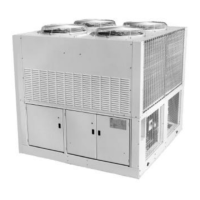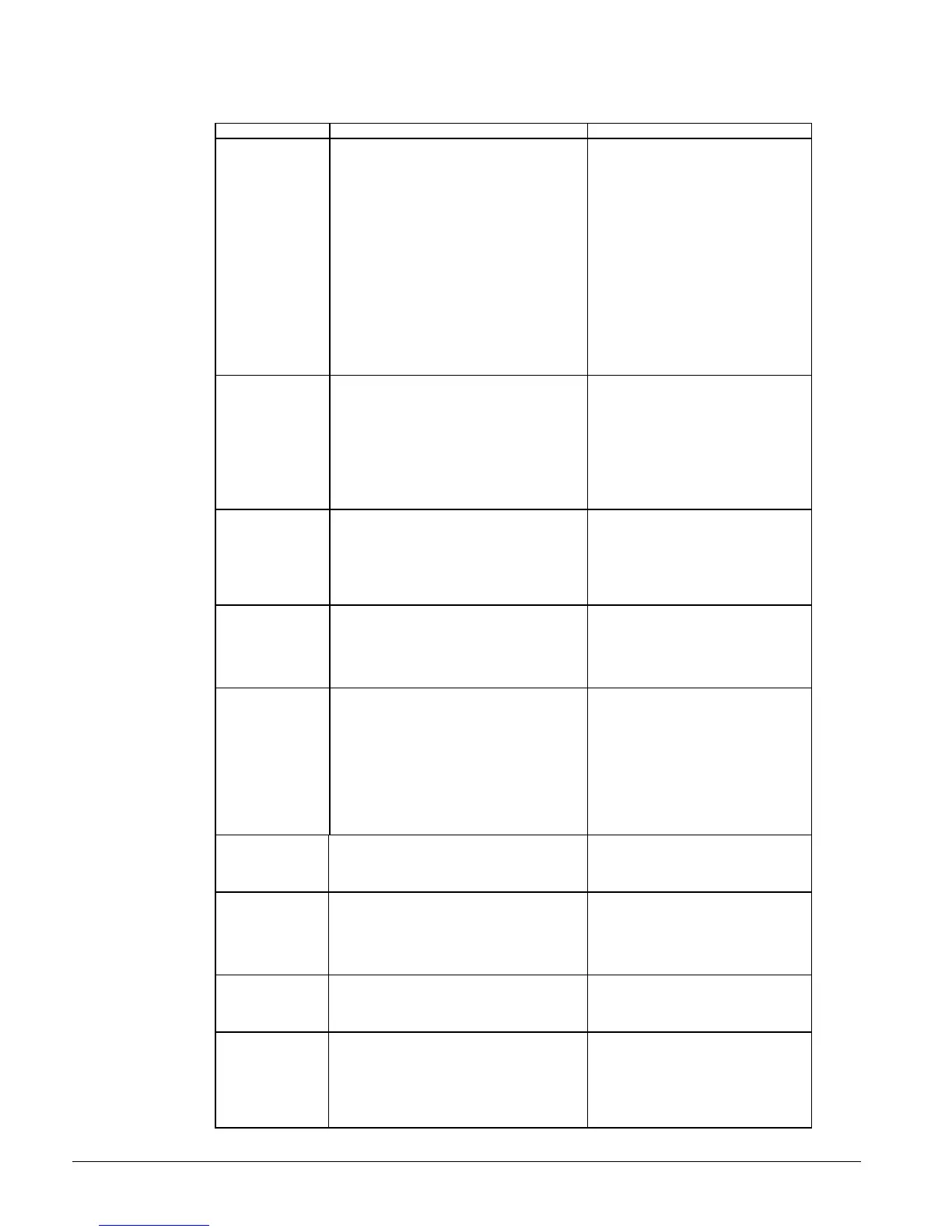60 IOMM ACZ/AGZ-1
Global UNT Controller Troubleshooting Chart
PROBLEM POSSIBLE CAUSES CORRECTIVE ACTIONS
Compressor will
not run
1. Main switch, circuit breakers open.
2. Fuse blown.
3. Thermal overloads tripped or fuses
blown.
4. Defective contactor or coil.
5. System shut down by safety devices.
6. No cooling required.
7. Liquid line solenoid will not open.
8. Motor electrical trouble.
9. Loose wiring.
1. Close switch.
2. Check electrical circuits and motor
winding for shorts or grounds.
Possible overloading. Replace fuse
or reset breakers after fault is
corrected.
3. Overloads are auto reset. Check
unit closely when operating again.
4. Repair or replace.
5. Determine type and cause of
shutdown and correct it before
resetting safety.
6. None. Wait for load.
7. Repair or replace.
8. Check motor for opens, shorts
circuit or burnout.
9. Check all wire junctions. Tighten
all terminals.
High Discharge
Pressure
1. Dirty condenser coils.
2. Fan not operating.
3. High Ambient conditions.
4. High return water temperature.
5. Overcharge of refrigerant.
6. Non condensable.
7. Discharge valve partially closed.
1. Clean.
2. Check fan motor, contactor,
contactor coil, fan pressure switch.
Repair or replace defective part.
3. Check against design conditions.
4. Disable a compressor on each.
5. Remove excessive amount of
charge.
6. Remove non condensable.
7. Back seat valve
Low Discharge
Pressure
1. Fan contactor failed in closed position.
2. Fan pressure switch defective.
3. Low ambient temps.
4. Low on refrigerant charge.
5. Reduced chilled water flow.
6. No load and on hot gas bypass.
1. Repair or replace.
2. Replace pressure switch.
3. Install SpeedTrol Kit.
4. Add refrigerant.
5. Check flow and correct.
6. Adjust hot gas bypass to maintain a
higher evaporator pressure.
High Suction
Pressure
1. Excessive load (high return water temp).
2. Controller not staging up.
3. Compressor capacity reduced.
4. Can be associated with high condenser
pressure.
1. Check water flow, reduce load.
2. Check UNT controller. Replace if
defective.
3. Replace compressor.
4. Check reasons for high condenser
pressure.
Low Suction
Pressure
1. Low refrigerant charge.
2. Defective expansion valve.
3. Dirty filter drier.
4. Reduced water flow.
5. Hot gas bypass valve not set properly.
6. Liquid line solenoid valve not opening.
7. UNT controller defective.
8. Gasket failure in evap head ring.
1. Add refrigerant.
2. Check operation. Repair or
replace.
3. Replace cores.
4. Increase water to design GPM.
5. Set valve for a higher pressure.
6. Repair or replace.
7. Check water sensor, set point dial,
control band dial. Calibrate, repair
or replace.
8. Replace gasket.
Compressor Oil
Loss
1. Excessive refrigerant flood back.
2. Defective crankcase heater.
3. Low refrigerant charge.
4. Hot gas bypass not set properly.
1. Check TXV. Repair or replace.
2. Replace heater.
3. Add refrigerant.
4. Increase hot gas flow.
Compressor
Overloads or
Circuit Breakers
Open
1. Low line voltage.
2. High compressor amps.
3. Loose power wiring.
4. High condenser pressures.
5. Single phasing.
1. Check incoming voltage. Report to
electrical supplier.
2. Determine cause and correct.
3. Tighten all connections.
4. Refer to High Condenser Pressure.
5. Replace fuses or breaker.
Compressor
Internal Motor
Switch Open
1. Compressor amps high.
2. Motor winding damaged.
1. Refer to the above concerning high
compressor amps.
2. Check motor winding resistance.
Replace if defective.
Freeze Protection
Trips
1. Pressure transducers defective.
2. Low water flow.
3. Low loads / erratic water flow.
4. Controller stage timing.
5. Defective TXV.
1. Compare output to actual
refrigerant pressures.
2. Check water GPM and correct.
3. Check pump operation, water
strainer, air handler control valves.
4. Check timing and reset as
necessary.

